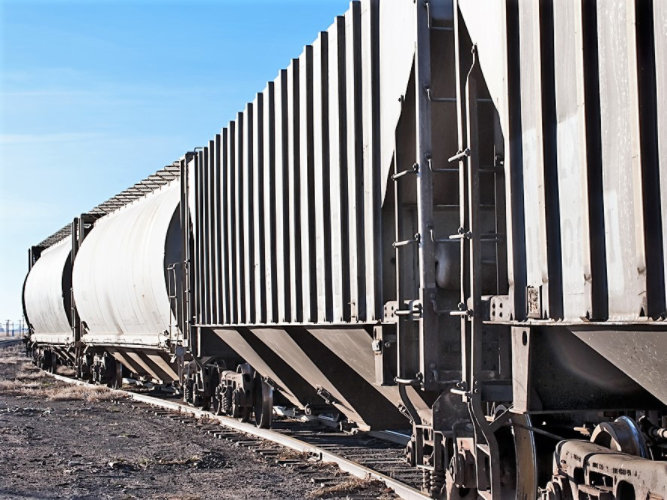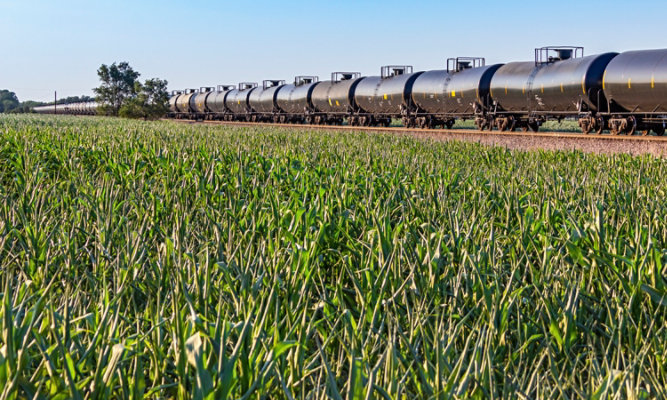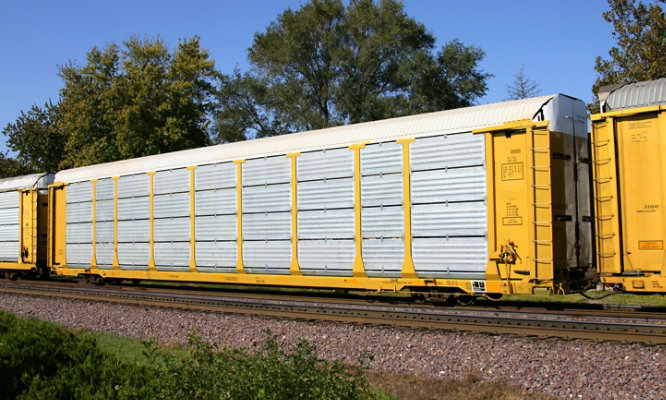How to Reduce the Total Applied Cost of Coating Railcar Exteriors
100% Solids Epoxies Trim Material and Application Costs
by Taylor Lewis, North America Sales Manager – Freight Rail

How long the exterior coatings should last on a new tank or hopper railcar is certainly debatable. Does the paint job only need to last through the car’s first inspection cycle, or could it provide sufficient corrosion protection to make it to the next inspection? The answer for many car owners depends on the total applied cost of the first coating application in either scenario. That answer will determine what type of coatings should be used.
For more than 20 years, the exteriors of tank and hopper railcars have been primarily coated with epoxies featuring a volume solids of about 80%. Such coating systems provide durable corrosion protection through at least a car’s first inspection cycle, which is usually between five and 10 years after being placed into service. While the coating may have some additional service life left at the time of inspection, it won’t hold up to the end of the second inspection cycle and will therefore require intermediate restoration. Since it is cost prohibitive to take a car out of service between planned inspections, owners typically approve the full removal and recoating of an exterior 80% volume solids coating after each inspection cycle (Figure 1). That might mean a car will receive five to six full recoats throughout its 40- to 50-year design service life.
Alternatively, car owners may decide to paint cars with an epoxy system featuring a 100% volume solids. Such coatings offer additional durability against impacts, abrasions, chemicals and corrosion and are therefore highly likely to make it through two railcar inspection cycles before requiring a full recoat. Therefore, a car may only need two to three full coating applications during its design service life with this premium coating.
To decide between the two coating options, owners must investigate the total applied cost of the first application. This “first cost” includes not only the cost of labor and materials to apply the car’s initial exterior coating, but also all of the ancillary shop costs associated with permitting fees, waste removal and tying up production space. It also includes the coating’s planned service life, which will be predetermined by the first or second scheduled inspection cycle.
The lower this first cost, the better. So, while a 100% solids epoxy may have higher upfront material costs than an 80% solids epoxy, it may be a better option since the owner can save the labor and material costs of an entire round of surface preparation and recoating before the second inspection cycle (Figure 2). Cost savings are also likely in the form of less material waste, as applicators are better able to control film builds when spraying 100% solids epoxies. In addition, 100% solids epoxies feature reduced volatile organic compound (VOC) emissions, which decreases shop permitting costs. Finally, a 100% solids epoxy also enables faster shop throughput and therefore faster returns to service for railcars. All of these savings add up to a net benefit when using a 100% solids epoxy compared to an 80% solids epoxy.
Figure 1. Tank cars featuring 80% solids epoxies are typically fully blasted and recoated after every five- to 10-year inspection cycle.
Figure 2. Hopper car exteriors face full restorations and recoats following either the first or second inspection cycle, depending on whether owners specify an 80% solids epoxy or a 100% solids epoxy, respectively.
Higher-Solids Epoxies Enable Cost Savings and Efficiencies
Railcars require inspections every eight to 10 years on average, with more frequent assessments necessary for cars hauling aggressive commodities. For example, cars that move polyethylene pellets for producing plastic packaging may have a 15-year inspection cycle, while cars transporting sulfur products must be inspected every five years.
Each inspection cycle carries a high downtime cost for car owners. Moving a car to and from a shop may cost upwards of $10,000 in transportation costs, transfer fees and other expenses. In addition, a car will typically be out of service for about 65 days during the process, representing significant lost revenue for car lessors, as well as lost capacity for car owners or lessees. Due to these high costs, railcar owners never want coatings to be the reason for sending a car to the shop, which is why they’ll recoat an 80% solids epoxy after the first inspection cycle or a 100% solids epoxy after the second inspection cycle, even if the applied coatings could last another few years.
The option to coat car exteriors with 100% solids epoxies hasn’t been considered much until recently, but the excellent performance of the same materials used as linings inside tank cars has proven their effectiveness at long-term corrosion protection. Car owners now realize they can count on these coatings to provide similar durability on car exteriors, providing a reliable service life of at least 20 years. This time frame allows owners to simply perform mechanical repairs during a car’s first inspection cycle – skipping a full recoat – and get another eight to 10 years out of the original coating job before recoating the car during the second inspection cycle. As a result, the owner will save significant money over the life of the asset.
Owners will also realize savings from a variety of properties 100% solids epoxy contain, as well as the efficiencies these properties enable, including:
- Enhanced Durability: Due to their higher solids content, 100% solids epoxies offer greater resistance to impacts and abrasions compared to 80% solids epoxies. These properties relate to the higher crosslink density found in the higher-solids materials. The tighter coating matrix is better able to resist external forces. It is also very effective at blocking moisture from penetrating the coating and leading to premature wear. While the coatings will still chalk like any epoxy, 100% solids epoxies lose fewer mils over time. Their enhanced durability enables longer service lives and the ability to make it to a second inspection cycle without concern.
- Better Edge Retention: Part of the enhanced durability that 100% solids epoxy formulations offer is related to their superior edge retention (Figure 3) compared to that of 80% solids epoxies (Figure 4). The 100% solids coatings lack solvents; therefore, less material evaporates as the coatings cure. That means welded edges, sharp seams and corners retain higher film builds upon curing, providing greater protection for these areas that are typically prone to damage and corrosion. Better protection means fewer repair needs and longer service lives, both of which reduce ownership costs.
- Improved Chemical Resistance: The tighter crosslink density of a 100% solids epoxy also improves its chemical resistance compared to 80% solids formulations. This ability enables such coatings to be used on cars hauling a wide array of commodities. For example, they can be used for the reinforced center band on tank cars hauling sulfuric acids. This band offers additional protection so splashes and spills of the corrosive tank commodities do not eat through the car’s steel. In these applications, a 100% solids epoxy can replace the water-based, graphite-filled acrylic coatings sometimes specified for center bands that require four to six coats and a long timeline to complete a single car.
- Faster Throughput: With water-based coatings, shops must apply multiple coating layers while also facing long curing times. A car may have to wait three days or longer after coating before being moved outside so precipitation won’t leave water spots behind. Epoxies with 80% volume solids cure much faster without worry of water spotting, and 100% solids epoxies cure even faster. For example, when applying a low-temperature curing, 100% solids epoxy in a single coat at a 4- to 6-mil dry film thickness (DFT), the shop has the option to let the coatings air cure, which may take four to eight hours depending on humidity, or heat cure for 60 to 90 minutes. Following curing, applicators then stencil the car and move it out of the shop to be returned to service. Even with air curing, the shop can complete a full car within a shift or by early the following day.
- Reduced VOCs: Epoxies containing 100% solids lack solvents and are therefore more environmentally friendly than 80% solids epoxies. More importantly, the solvent-free formulations provide savings for application shops, which are required to pay permitting fees for the abatement of VOCs released from their coating operations. Fewer VOCs means reduced permitting fees and lower applied costs.
- Reduced Consumption and Waste: By applying 100% solids epoxies direct to metal, owners and applicators save the material costs and time associated with applying a primer coat, while also reducing shop inventory needs. In addition, applicators are better able to control the application of 100% solids materials through plural-component equipment compared to 80% solids epoxies, providing more consistency in application DFTs and less chance of applying unnecessarily high film builds that waste materials and money. Because 100% solids are applied with heated plural-component equipment, the viscosity of the product can be adjusted for optimal spray application via heat rather than by adding solvent. Plural-component spray applications also help with component ratio assurance compared to batch mixing a few buckets by hand, which can be prone to human mixing errors. Shops can also reduce costs by using cartridges or burst pouches for coating touchups, as these options eliminate waste associated with mixing errors and preparing too much touchup material.
Calculating Coating Application Frequency
A common design service life target for tank cars is about 40 years, with 50 years or more being feasible for many cars. Assuming a car will hit that 50-year mark, the cost-saving advantages of a 100% solid epoxy over an 80% epoxy are evident based on the number of full recoats required, as well as the associated savings noted previously (Figure 5). The table below details a few coating scenarios for comparison, using an eight- to 10-year inspection cycle.
Although an 80% solids coating may last longer than this inspection cycle, it will not make it through two cycles. Therefore, the car will be recoated following each inspection due to the exorbitant cost of returning a car to a shop for recoating. The added durability of the 100% solids coating should enable car owners to skip every other inspection cycle for a full recoat. As a result, the 80% solids coating will require five to six full coating applications to reach the 50-year mark (see Scenario 1), while the 100% solids coating will only need two to three full applications (see Scenario 2).
The final number of applications may vary based on more frequent inspection intervals, the actual condition of the coatings when inspected and the condition of the car. For example, in Scenario 2, the third application of a 100% solids epoxy at the 40- to 50-year mark may not be completed if the car is not expected to last another 16 to 20 years. In fact, the owner may decide to apply an 80% solids material at this time – or deploy other cost-saving corrosion control strategies such as overcoating or spot repairs – to get another eight to 10 years of life, while saving the cost of a full application of the more robust coating system.
Even if a car started its life with an 80% solids epoxy, savings can be realized by transitioning to a 100% solids epoxy for subsequent applications – either after the first or second 80% solids epoxy application (see Scenarios 3 and 4). In either case, the owner may only need to coat the car three times during its service life. Scenario 3 spreads coating-related costs over a longer time frame and is also a more economical option than Scenario 4, especially if the car is in good condition and has more bonus life after inspection cycle 5.
Figure 3. The superior edge retention of a 100% solids epoxy leaves higher coating film builds on sharp corners (shown) and edges, providing greater protection from damage and corrosion.
Figure 4. Coatings not formulated for edge retention lose sufficient film build at corners (shown at upper right), welds and angles, reducing their durability and corrosion protection in these areas.
Figure 5. Despite the higher initial material cost of a 100% solids epoxy, the savings associated with its application properties and longevity add up to a net benefit compared an 80% solids epoxy.
Scenario |
Variable | Cycle 1 |
Cycle 2 |
Cycle 3 |
Cycle 4 |
Cycle 5 |
Cycle 6 |
|---|---|---|---|---|---|---|---|
|
Scenario – |
Variable
Tank Car Life |
Cycle 1 8-10 |
Cycle 2 16-20 Years |
Cycle 3 24-30 Years |
Cycle 4 32-40 Years |
Cycle 5 40-50 Years |
Cycle 6 48-60 Years |
|
Scenario 1 |
Variable
80% Solids Epoxy |
Cycle 1 ● |
Cycle 2 ● |
Cycle 3 ● |
Cycle 4 ● |
Cycle 5 ● |
Cycle 6 ●* |
|
Scenario 2 |
Variable
100% Solids Epoxy |
Cycle 1 ■ |
Cycle 2
|
Cycle 3 ■ |
Cycle 4
|
Cycle 5 ■* |
Cycle 6
|
|
Scenario 3 |
Variable
80% Solids Epoxy for First Application; 100% Solids Epoxy Thereafter |
Cycle 1 ● |
Cycle 2 ■ |
Cycle 3
|
Cycle 4 ■ |
Cycle 5
|
Cycle 6 ■* |
|
Scenario 4 |
Variable
80% Solids Epoxy for First Two Applications; 100% Solids Epoxy Thereafter |
Cycle 1 ● |
Cycle 2 ● |
Cycle 3 ■ |
Cycle 4
|
Cycle 5 ■* |
Cycle 6
|
● 80% solids epoxy application
■ 100% solids epoxy application
* Coating application optional, and perhaps unlikely, due to the approaching end of the car’s design service life
Total Applied Cost Analysis Favors Higher-Solids Epoxies
Using the total applied cost as the deciding factor between using an 80% solids epoxy and a 100% solids epoxy for railcar exteriors is a helpful way for car owners to determine the most economical approach for their operations. While the most economical choice on the front end may seem to be a lower-cost, 80% solids coating, the associated backend costs related to more frequent car restorations, reduced durability and higher application costs make 100% solids coatings a better choice in nearly any cost-benefit analysis scenario. However, the final decision may also depend on whether the owner intends to keep or sell the railcar after a number of years.
For car owners, the most value gained by using 100% solids epoxies is the additional inspection cycle they get before needing to recoat a car. But value also comes in the form of predictability, as owners are able to accurately predict the life cycle of the coatings and plan their full car recoats accordingly. Both factors enable owners to make critical decisions related to asset depreciation. For example, many leasing companies choose to sell railcars just before they approach an inspection cycle so they don’t have to deal with the logistics of getting the car fully recoated. That period is usually around five or seven years when using 80% solids epoxies since cars will need to be recoated during the first inspection cycle. The additional service life a 100% solids epoxy coating offers may enable the leasing company to hold onto a railcar longer, perhaps for 10 to 14 years, while still avoiding the responsibility of managing a full car recoat.
For coating application shops, the transition to higher solids coatings provides notable throughput and waste reduction advantages, allowing applicators to rapidly move cars through a shop while saving labor and material costs for a lower total applied cost.
Crunching the numbers to arrive at an accurate total applied cost comparison will help railcar owners and applicators determine the most economical option for coating car exteriors. While an owner may have once thought 100% solids epoxies were too expensive, an analysis of the numerous variables involved will likely prove that 80% solids epoxies are the more expensive option.
ABOUT THE AUTHOR
Taylor Lewis is Business Development Manager – Freight Rail for Sherwin-Williams Protective & Marine. He is a NACE Coating Inspector Level II – Certified and has 16 years of experience in the coatings industry, including multiple roles in sales and marketing spanning from Alaska to the Gulf of Mexico. Contact: Taylor.Lewis@sherwin.com
Discover More
Industry Expertise and Innovation
See how we help customers find customized solutions for their project and application challenges.
Our Rail Expertise
Explore our industry solutions and technology to help protect your assets.
LEARN MOREProduct Lookup
Find out more about our innovative coatings for a variety of industries.
FIND A PRODUCT
